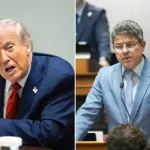
Federal Reserve Chairman Jerome Powell on Friday warned more interest rate hikes are possible but added the central bank will “proceed carefully” when deciding its next steps.
Powell delivered his much-anticipated annual address at the Jackson Hole Symposium on Friday morning and stressed that the central bank might not be done with its tightening cycle quite yet, leaving the door open to more rate hikes.
NIKKI HALEY CLAIMED DEBATE SPOTLIGHT AMONG CROWD OF ‘SCREAMING MEN’
“At upcoming meetings, we will assess our progress based on the totality of the data and the evolving outlook and risks,” he said during his speech in Jackson Hole, Wyoming. “Based on this assessment, we will proceed carefully as we decide whether to tighten further or, instead, to hold the policy rate constant and await further data.”
The annual address, which has the ability to move global markets, was more muted than last year’s speech, when Powell warned of “pain” to households and businesses as a result of tightening. He stayed on message and stuck closely to what he has said about future rate hikes at other events.
The speech seemed about in line with investor expectations as stocks were essentially flat following its delivery.

Still, Powell acknowledged that the series of rate hikes, which has brought the Fed’s interest rate target to 5.25% to 5.50%, is still expected to cause some economic slowdown and negative effects on the job market.
“Getting inflation sustainably back down to 2% is expected to require a period of below-trend economic growth as well as some softening in labor market conditions,” he said.
Headline inflation, as gauged by the consumer price index, is now hovering at 3.2% — still above the Fed’s goal of 2% long-run inflation. Some economists have recently suggested raising that target to 3%, although Powell used his time at the podium to reiterate that 2% still remains the Fed’s benchmark.
“Two percent is and will remain our inflation target. We are committed to achieving and sustaining a stance of monetary policy that is sufficiently restrictive to bring inflation down to that level over time,” he told the gathering of economists, journalists, and government officials.
During the speech, Powell honed in on “core inflation,” which strips out volatile food and energy prices and is considered to be an indicator of sticky inflation, is still running at a 4.7% annual rate (although in July it also only ticked up 0.2%). Sticky inflation is inflation that doesn’t respond quickly to changes in demand.
“The lower monthly readings for core inflation in June and July were welcome, but two months of good data are only the beginning of what it will take to build confidence that inflation is moving down sustainably toward our goal,” the chairman said. “We can’t yet know the extent to which these lower readings will continue or where underlying inflation will settle over coming quarters.”
Brian Marks, executive director of the University of New Haven’s Entrepreneurship and Innovation Program, told the Washington Examiner after the speech that the tone of the speech was “somewhat hawkish.” Marks said he was surprised that the banking sector wasn’t mentioned, but said the rest of the speech was in line with expectations.
Prior to the speech, most investors expected the Fed to hold rates steady at its September meeting. That didn’t change following the speech.
About 83% think that the Fed will hold rates steady, according to CME Group’s FedWatch tool, which calculates the probability using futures contract prices for rates in the short-term market targeted by the Fed. That is about the same as a day ago but slightly lower than a week ago.
What Powell didn’t talk about is when the Fed might start cutting rates. Most investors now think that rates will remain elevated into next year, with just over 40% thinking they will be lower in May 2022 than today.
While recession odds are lower than they were just six months ago, many economists are still penciling in some sort of economic downturn, including PNC chief economist Gus Faucher, who expects rate cuts to begin next spring.
“PNC expects a mild recession starting in early 2024 as the cumulative impact of tighter monetary policy leads to contraction in interest-rate sensitive sectors like consumer spending on durable goods and business investment spending,” he said.
“PNC then expects the FOMC to start cutting the fed funds rate in the early spring of next year as it becomes apparent that the economy is in recession and inflation is moving to 2%,” he added.
CLICK HERE TO READ MORE FROM THE WASHINGTON EXAMINER
Of note, Powell himself didn’t say the phrase “recession” once in the entire address, although he did mention “below-trend economic growth.”
During the last meeting of central bank officials, it was revealed that Fed staff no longer expect a recession. That announcement was significant because just months ago Fed staff had been penciling in a mild recession this year.





